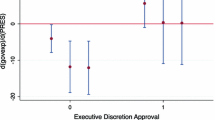Abstract
This paper reconsiders the impact of the governor's line-item veto on the state budget process. The governor's ability to obtain his or her most desired budget measures item veto effectiveness, rather than a smaller expenditure budget. The percentage difference between the final state budget and the governor's original budget request over fiscal years 1983–1989 is examined. The empirical results indicate that under certain political situations the line-item veto authority enhances the governor's ability to obtain his or her desired budget.
Similar content being viewed by others
References
Abney, G. and Lauth, T.R. (1985). The line-item veto in the states: An instrument for fiscal restraint or an instrument for partainship?Public Administration Review 45(3): 372–377.
Abrams, B.A. and Dougan, W.R. (1986). The effects of constitutional restraints on governmental spending.Public Choice 49(2): 101–116.
Alm, J. and Evers, M. (1991). The item veto and state government expenditures.Public Choice 68(1–3): 1–15.
Baron, D.P. and Ferejohn, J.A. (1989). Bargaining in legislatures.American Political Science Review 83(4): 1181–1206.
Buchanan, J.M. and Tullock, G. (1962).The calculus of consent. Ann Arbor: The University of Michigan Press.
Carter, J.R. and Schap, D. (1987). Executive veto, legislative override, and structure-induced equilibrium.Public Choice 52(3): 227–244.
Carter, J.R. and Schap, D. (1990). Line item veto: Where is thy sting?Journal of Economic Perspectives 4(2): 103–118.
Citizens Conference on State Legislatures. (1971).State legislatures: An evaluation of their effectiveness. New York: Praeger.
Dearden, J.A. and Husted, T.A. (1990). Executive budget proposal, executive veto, legislative override, and uncertainty: A comparative analysis of the budgetary process.Public Choice 65(1): 1–20.
Dye, T.R. (1969). Income inequality and American state politics.American Political Science Review 63(1): 157–162.
Holtz-Eakin, D. (1986). Unobserved tastes and the determination of municipal services.National Tax Journal 39(4): 527–532.
Holtz-Eakin, D. (1988). The line item veto and public sector budgets: Evidence from the states.Journal of Public Economics 36(3): 269–292.
Husted, T.A. (forthcoming). Changes in state income inequality from 1981 to 1987.The Review of Regional Studies 21(3).
Hsiao, Cheng (1986).Analysis of panel data. Cambridge: Cambridge University Press.
Rowley, C.K., Shughart II, W.F. and Tollison, R.D. (1987). Interest groups and deficits. In J.M. Buchanan, C.K. Rowley, and R.D. Tollison (Eds.),Deficits, 263–280. New York: Basil Blackwell.
Rubinstein, A. (1982). Perfect equilibrium in a bargaining model.Econometrica 50(1): 97–109.
Selten, R. (1965). Spieltheoretische Behandlung eines Oligopolmodells mit Nachfrageträgheit.Zeitschrift für die gesamte Staatswissenschaft 12: 301–324.
Selten, R. (1975). Reexamination of the perfectness concept for equilibrium points in extensive form games.International Journal of Game Theory 4(1): 25–55.
U.S. Congress, House, Committee on Rules (1986).Item veto: State experience and its application to the federal situation. 99th Congress, 2nd. Session, Washington: U.S. Government Printing Office.
Weingast, B.R. (1989). Floor behavior in the U.S. Congress: Committee power under the open rule.American Political Science Review 83(3): 795–815.
Weingast, B.R. and Marshall, W.J. (1988). The industrial organization of Congress; or, why legislatures, like firms, are not organized as markets.Journal of Political Economy 96(1): 132–163.
Author information
Authors and Affiliations
Additional information
We would like to thank the Editors for helpful comments and suggestions.
Rights and permissions
About this article
Cite this article
Dearden, J.A., Husted, T.A. Do governors get what they want?: An alternative examination of the line-item veto. Public Choice 77, 707–723 (1993). https://doi.org/10.1007/BF01047990
Accepted:
Issue Date:
DOI: https://doi.org/10.1007/BF01047990




